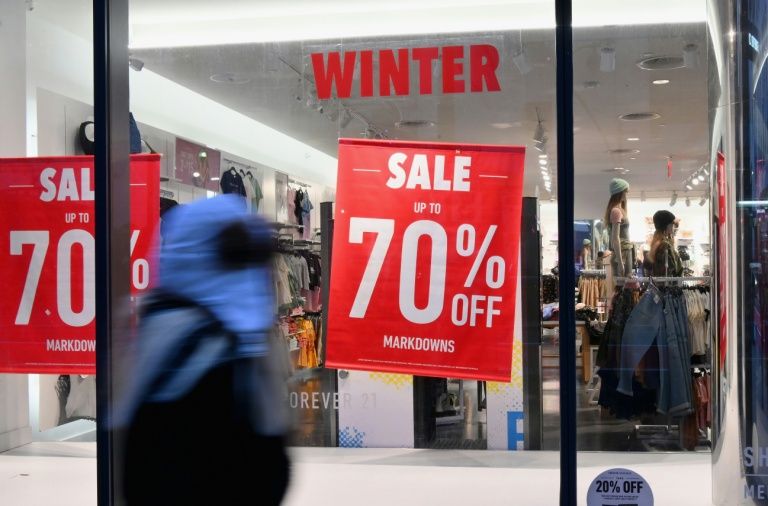Fearful US consumers await Biden stimulus injection
Washington (AFP) – President-elect Joe Biden’s stimulus plan could spur hesitant US consumers to start spending again, analysts said Friday, as the government reported falling sales in December, but they warned it may not be enough to overcome surging coronavirus cases.
Biden on Thursday unveiled a $1.9 trillion package aimed at getting the world’s largest economy back on its feet after business shutdowns to stop Covid-19 caused a massive downturn in 2020.
The package, dubbed the American Rescue Plan, would raise the minimum wage to $15 an hour, fund struggling state and local governments, send larger stimulus checks to consumers and pay for a renewed testing and vaccination assault on the coronavirus.
Those provisions could help return shoppers to the struggling retail sector, where the Commerce Department said Friday sales fell 0.7 percent during the December holiday season as even booming e-commerce outlets did less business.
“President-elect Biden’s ambitious fiscal agenda could further juice up household spending during the delicate vaccine rollout phase. Thereafter, consumers’ mood should revive as herd immunity comes within reach and further fiscal aid is delivered,” Lydia Boussour of Oxford Economics said.
But with Covid-19 cases still at worrying levels across the economy, Ian Shepherdson of Pantheon Macroeconomics feared that even Biden’s massive plan won’t be enough to lure people back to stores.
“We expect consumers’ spending to struggle until falling Covid cases allow restrictions to be eased, starting in March. We think most of the next round of stimulus payments, proposed yesterday by President-elect Biden, will be saved,” Shepherdson said.
– Worrying signs-
The retail sales data follows recent Labor Department statistics showing weekly claims for new unemployment benefits increasing, and the economy shedding jobs in December.
Biden’s proposal would cushion the blow for the unemployed by increasing the amount of weekly payments and lengthening their duration, while also raising stimulus payments included in a December measure to $2,000 from $600.
But the package’s prospects in Congress, which is controlled only narrowly by Biden’s Democrats, are unclear.
Party leaders have promised they’ll act on the proposal swiftly, but at least one key senator has expressed reservations about its provisions.
The National Retail Federation industry group sounded a positive note, saying: “We support providing critical government assistance in the form of direct payments to families and individuals whose lives have been disrupted, further aid for small businesses across the country, and tools to keep businesses open and the economy growing.”
– Tough year –
Overall, the Commerce Department said retail sales in the final month of 2020 were up only 2.9 percent from last year, weaker than the 5.8 percent growth seen from December 2018.
And December was a particularly bad month, with sales excluding the volatile auto sector declining 1.4 percent from November.
Non-store retailers, such as those in the e-commerce sector, saw their usually strong business taper off last month, dipping 5.8 percent.
The report caps a year that saw massive upheavals for businesses, with some prospering but others slumping under the weight of the coronavirus.
Non-store retailers saw sales rise 19.2 percent in December from the end of 2019 and building materials and gardening equipment were up 17.0 percent.
Grocery stores gained 8.9 percent last year as more people cooked at home and occasionally stockpiled, while sporting goods, hobby, book and musical instrument stores saw sales jump 15.2 percent.
Many other types of retailer suffered as the arrival of Covid-19 made shopping trips potentially perilous.
Clothing and accessories stores were down 16 percent from December 2019, electronics stores lost 16.6 percent and food and drink outlets, like the eateries which were among the first businesses shuttered when the virus arrived, plunged 21.2 percent.
The virus also sunk oil prices, pushing gasoline station sales down 12.2 percent in 2020.
Rubeela Farooqi of High Frequency Economics warned Biden’s plan may not be enough to revitalize shoppers immediately.
“Much-needed fiscal support measures will limit damage to household balance sheets but given uncertain economic and job prospects, it is unclear how much support consumer spending will provide to growth in the very near term,” she said.
There were signs the recovery was continuing elsewhere in the economy, with the Federal Reserve on Friday reporting industrial production in December grew well above expectation by 1.6 percent, aided by gains in utilities and mining.
Disclaimer: Validity of the above story is for 7 Days from original date of publishing. Source: AFP.


